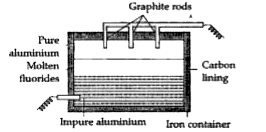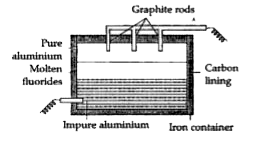The following questions related to the extraction of aluminium by electrolysis :
What is the role of graphite?
Step-by-Step Solution:
1. Understanding the Process: The extraction of aluminum is done through the electrolysis of alumina (Al₂O₃). In this process, electrical energy is used to break down alumina into aluminum and oxygen.
2. Role of Graphite: In the electrolysis setup, graphite is used as the anode (the positive electrode). The anode plays a crucial role in the overall reaction during the electrolysis process.
3. Reactions at the Cathode: At the cathode (the negative electrode), aluminum ions (Al³⁺) are reduced to form aluminum metal (Al). This occurs when aluminum ions gain electrons.
- Reaction: Al³⁺ + 3e⁻ → Al (s)
4. Reactions at the Anode: At the anode, oxidation reactions take place. The oxide ions (O²⁻) migrate towards the anode and react with the graphite.
- Reactions:
- 2O²⁻ → O₂ (g) + 4e⁻ (this would normally happen but is prevented)
- O²⁻ + C (graphite) → CO (g) + 2e⁻
- 2O²⁻ + C (graphite) → CO₂ (g) + 4e⁻
5. Preventing Oxygen Evolution: The graphite anode prevents the evolution of oxygen gas. If oxygen were to be produced, it could react with the aluminum produced at the cathode, leading to oxidation of aluminum.
6. Conclusion: Thus, the role of graphite in the electrolysis of alumina is twofold: it serves as the anode and prevents the formation of oxygen gas, which would otherwise oxidize the aluminum.
- 2O²⁻ → O₂ (g) + 4e⁻ (this would normally happen but is prevented)
- O²⁻ + C (graphite) → CO (g) + 2e⁻
- 2O²⁻ + C (graphite) → CO₂ (g) + 4e⁻
Topper's Solved these Questions
Similar Questions
The following questions related to the extraction of aluminium by electrolysis :
Give the equation for the reaction that takes place at cathode.
View SolutionThe following questions relate to the extraction of aluminium by electrolysis :
Give the equation for the reaction that takes place at the cathode.
View SolutionThe following questions relate to the extraction of aluminium by electrolysis :
Explain why is it necessary to renew the anode periodically.
View SolutionThe following questions related to the extraction of aluminium by electrolysis :
Explain why it is necessary to renew anode from time to time?
View SolutionThe following questions relate to the extraction of aluminium by electrolysis :
Name the other aluminium containing compound added to alumina and state its significance.
View SolutionThe following question relate to the extraction of aluminium by electrolysis:

Give the equation for the reaction that takes place at the cathode.
View SolutionThe following question relate to the extraction of aluminium by electrolysis:

Explain why is it necessary to renew the anode periodically.
View SolutionThe following question relate to the extraction of aluminium by electrolysis.
Give equation for the reaction that takes place at the cathode.
View SolutionThe following question relate to the extraction of aluminium by electrolysis:

Name the other aluminium containing compound added to alumina and state its significance.
View SolutionThe following question relate to the extraction of aluminium by electrolysis.
Name the other aluminium-containing compound added to alumina and write its significance.
View Solution
